As we are all spending more time at home, we have put together some top tips to help you support the wildlife on your own doorstep; you might think of more as you start! Most of these have been tried and tested down the Open Country Allotment or by our Conservation and Nature Force groups. Don’t forget to send us photos of your hard work via our Facebook page (@OpenCountryYorkshire) or to our email address (info@opencountry.org.uk).
1. FEED THE BIRDS
Although winter feeding benefits birds the most, natural food shortages can occur at any time of year. The RSPB suggest that during the warmer months, birds require high protein foods, especially whilst they are moulting. At this time of year you should put out oatmeal, sultanas, raisins, currants, mild grated cheese, black sunflower seeds and mealworms. Why not recycle a plastic bottle into a homemade bird feeder and hang it from a tree or washing line? Don’t forget that it’s also important to provide birds with clean water for them to drink and bathe in.
 Photo: Natural History Museum
Photo: Natural History Museum
2. LET THE GRASS GROW LONG
Giving your lawn mower (and yourself!) a rest and letting the grass grow can be really beneficial to insect life and small mammals, as the long grass gives them a safe haven to hide in. You’ll be able to see what wildflowers come up; which will be good for bees and butterflies too. You might need to supplement the flowers by planting plugs (young plants) or sowing seeds, something our Nature Force group in Wakefield have become very good at!
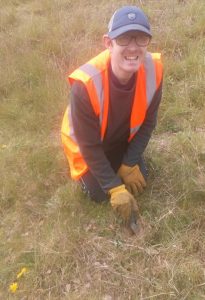
3. MAKE A BUG HOTEL
When you get bugs and beetles in your garden, you help start the food chain. Insects need lots of little holes, nooks and crannies to hide in. You can use an old wooden box and fill it full of bamboo, twigs, pine cones, plant pots and straws. There are lots of photos online to give you inspiration and if you don’t have a garden, you can make a smaller one and attach it to your wall or fence. Here’s one the Conservation Group made out of an old wooden pallet.
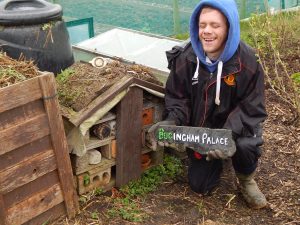
4. MAKE A ‘HOGITAT’
Hedgehogs have declined massively in the UK over recent years so they need all the help they can get. Why not make a hogitat to give them a safe space to breed and hibernate in? You can make a bigger one as a woodworking project or start simple with a temporary cardboard home covered in plastic to make it waterproof. Don’t forget to decorate it! We can also help our prickly friends by putting food and water out for them. The British Hedgehog Preservation Society recommend offering them a good quality hedgehog food, meaty cat or dog food or dry biscuits for cats. You can make sure that hedgehogs have easy access to your garden by checking that your fence or wall has a 13cm x 13cm gap (about the size of a CD case) in the bottom to allow them to pass through. Here’s one our Wild About Wetherby group made for the OC allotment, we covered it with leaves and twigs for extra protection.
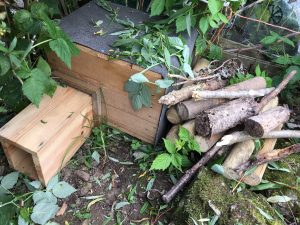
5. MAKE A POND OUT OF A RECYCLED CONTAINER
Use your imagination to create a pond for our froggy friends using an old container. A washing up bowl makes a great mini-pond. You can add wood, pebbles, plant pots and native pond plants such as frogbit, bogbean and water mint (if available). Last spring we installed a second pond down the OC allotment and were rewarded with visits from damselflies, frogs and pond skaters!
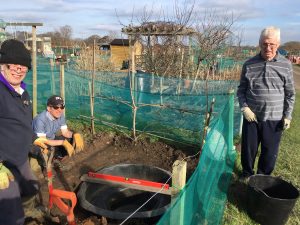
6. SOW WILDFLOWER SEEDS
Most supermarkets sell native wildflower seeds for you to plant in your garden or in plant pots on your patio or window ledge. Wildflowers grow in nutrient deprived soil so don’t bother buying any special compost to put them in. Wildflowers not only add colour to the garden, they help feed bees and butterflies. Butterfly Conservation have a list of nectar plants for butterflies, and the Bumblebee Conservation Trust have some good tips on what flowers to plant to help boost your local bee populations. We also love this article from Happy DIY Home about designing a garden fit for a queen bee! We sowed packets of wildflowers seeds straight on to our scarecrow bed down the allotment and we were delighted with this lovely display of colour.
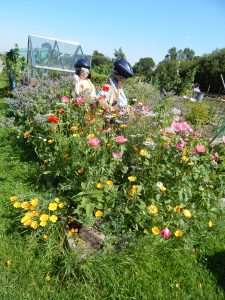
7. GROW CLIMBING PLANTS
Gardeners’ World have a list of ‘10 of the best climbers for wildlife’, which includes passion flower, honeysuckle, ivy and wisteria. They say that ‘Climbers are worth their weight in gold for wildlife, clothing walls and fences, and hiding unsightly views. They also add ornamental interest with pretty foliage and flowers, many of which are scented.’
8. MAKE A BIRD NEST BOX
If you have some spare wood around the house or garage, why not put it to good use? You can make a robin or wren nest box with just a few planks of wood, nails, a hammer and a saw (get someone to help you if you need it!). The British Trust for Ornithology provide useful information about building your nest box, including designs and dimensions. Our Conservation and Nature Force groups have been busy constructing bird and bat boxes over the winter, and have been erecting them in local churchyards and nature reserves.

9. FEED THE BUTTERFLIES
As well as planting flowers, why not create a hanging food platter to give extra help for our struggling butterfly species? There are many designs out there, but most involve putting ripe fruit on a tray or paper plate outdoors. Be careful to keep the fruit off the ground, as this can bring in unwanted rodents.
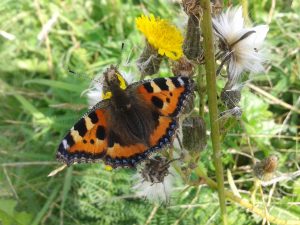
10. MAKE A WORMERY
More of an educational tip this one; worms are a life essential (without them we wouldn’t have soil to grow vegetables) and fascinating to watch, so why not get them off to a great start with a homemade wormery? If you use a clear container, you can while away the hours by watching them do their magic too! See the RHS website for a guide to making your own mini wormery.
Good luck and don’t forget to let us know how you got on!


Recent Comments